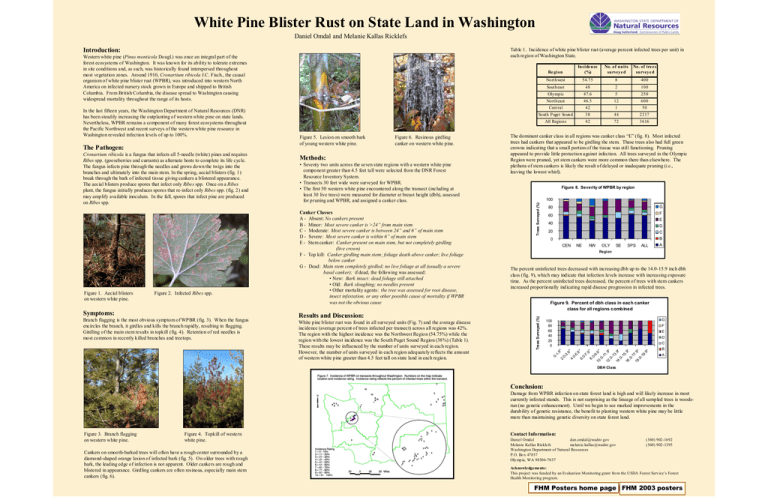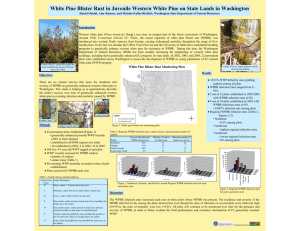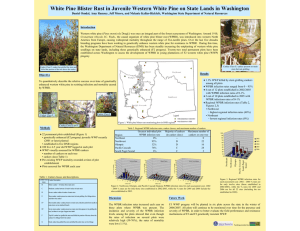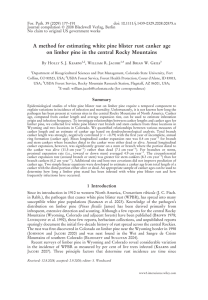White Pine Blister Rust on State Land in Washington Introduction:
advertisement

White Pine Blister Rust on State Land in Washington Daniel Omdal and Melanie Kallas Ricklefs Introduction: Table 1. Incidence of white pine blister rust (average percent infected trees per unit) in each region of Washington State. Cronartium ribicola is a fungus that infects all 5-needle (white) pines and requires Ribes spp. (gooseberries and currants) as alternate hosts to complete its life cycle. The fungus infects pine through the needles and grows down the twigs into the branches and ultimately into the main stem. In the spring, aecial blisters (fig. 1) break through the bark of infected tissue giving cankers a blistered appearance. The aecial blisters produce spores that infect only Ribes spp. Once on a Ribes plant, the fungus initially produces spores that re-infect only Ribes spp. (fig. 2) and may amplify available inoculum. In the fall, spores that infect pine are produced on Ribes spp. Figure 1. Aecial blisters on western white pine. Figure 2. Infected Ribes spp. Symptoms: Branch flagging is the most obvious symptom of WPBR (fig. 3). When the fungus encircles the branch, it girdles and kills the branch rapidly, resulting in flagging. Girdling of the main stem results in topkill (fig. 4). Retention of red needles is most common in recently killed branches and treetops. Figure 6. Resinous girdling canker on western white pine. Methods: • Seventy two units across the seven state regions with a western white pine component greater than 4.5 feet tall were selected from the DNR Forest Resource Inventory System. • Transects 30 feet wide were surveyed for WPBR. • The first 50 western white pine encountered along the transect (including at least 30 live trees) were measured for diameter at breast height (dbh), assessed for pruning and WPBR, and assigned a canker class. Canker Classes A - Absent: No cankers present B - Minor: Most severe canker is >24” from main stem C - Moderate: Most severe canker is between 24” and 6” of main stem D - Severe: Most severe canker is within 6” of main stem E - Stem canker: Canker present on main stem, but not completely girdling (live crown) F - Top kill: Canker girdling main stem; foliage death above canker; live foliage below canker G - Dead: Main stem completely girdled; no live foliage at all (usually a severe basal canker); if dead, the following was assessed: • New: Bark intact: dead foliage still attached • Old: Bark sloughing; no needles present • Other mortality agents: the tree was assessed for root disease, insect infestation, or any other possible cause of mortality if WPBR was not the obvious cause Results and Discussion: White pine blister rust was found in all surveyed units (Fig. 7) and the average disease incidence (average percent of trees infected per transect) across all regions was 42%. The region with the highest incidence was the Northwest Region (54.75%) while the region with the lowest incidence was the South Puget Sound Region (38%) (Table 1). These results may be influenced by the number of units surveyed in each region. However, the number of units surveyed in each region adequately reflects the amount of western white pine greater than 4.5 feet tall on state land in each region. No. of units surveye d No. of tre e s surveye d Northwest 54.75 8 400 Southeast 48 2 100 Olympic 47.6 5 250 Northeast Central 46.5 42 12 1 600 50 South Puget Sound 38 44 2217 All Regions 42 72 3616 The dominant canker class in all regions was canker class “E” (fig. 8). Most infected trees had cankers that appeared to be girdling the stem. These trees also had full green crowns indicating that a small portion of the tissue was still functioning. Pruning appeared to provide little protection against infection. All trees surveyed in the Olympic Region were pruned, yet stem cankers were more common there than elsewhere. The plethora of stem cankers is likely the result of delayed or inadequate pruning (i.e., leaving the lowest whirl). Figure 8. Severity of WPBR by region 100% G 80% F 60% E 40% D 20% C B 0% CEN NE NW OLY SE SPS ALL A Region The percent uninfected trees decreased with increasing dbh up to the 14.0-15.9 inch dbh class (fig. 9), which may indicate that infection levels increase with increasing exposure time. As the percent uninfected trees decreased, the percent of trees with stem cankers increased proportionally indicating rapid disease progression in infected trees. Figure 9. Percent of dbh class in each canker class for all regions combined G 100% 80% 60% 40% 20% 0% F E D C 01. 9" 2. 03. 9" 4. 05. 9 " 6. 07 .9 " 8. 09. 10 9" .0 -1 1. 12 9" .0 -1 3. 14 9" .0 -1 5. 16 9" .0 -1 7. 18 9" .0 -1 9. 9" The Pathogen: Figure 5. Lesion on smooth bark of young western white pine. Incide nce (%) Trees Surveyed (%) In the last fifteen years, the Washington Department of Natural Resources (DNR) has been steadily increasing the outplanting of western white pine on state lands. Nevertheless, WPBR remains a component of many forest ecosystems throughout the Pacific Northwest and recent surveys of the western white pine resource in Washington revealed infection levels of up to 100%. Re gion Trees Surveyed (%) Western white pine (Pinus monticola Dougl.) was once an integral part of the forest ecosystems of Washington. It was known for its ability to tolerate extremes in site conditions and, as such, was historically found interspersed throughout most vegetation zones. Around 1910, Cronartium ribicola J.C. Fisch., the causal organism of white pine blister rust (WPBR), was introduced into western North America on infected nursery stock grown in Europe and shipped to British Columbia. From British Columbia, the disease spread to Washington causing widespread mortality throughout the range of its hosts. B A DBH Class Conclusion: Damage from WPBR infection on state forest land is high and will likely increase in most currently infested stands. This is not surprising as the lineage of all sampled trees is woodsrun (no genetic enhancement). Until we begin to see marked improvements in the durability of genetic resistance, the benefit to planting western white pine may be little more than maintaining genetic diversity on state forest land. Figure 3. Branch flagging on western white pine. Figure 4. Topkill of western white pine. Cankers on smooth-barked trees will often have a rough center surrounded by a diamond-shaped orange lesion of infected bark (fig. 5). On older trees with rough bark, the leading edge of infection is not apparent. Older cankers are rough and blistered in appearance. Girdling cankers are often resinous, especially main stem cankers (fig. 6). Contact Information: Daniel Omdal dan.omdal@wadnr.gov Melanie Kallas Ricklefs melan ie.kallas@wadnr.gov Washington Department of Natural Resources P.O. Bo x 47037 Oly mp ia, WA 98504-7037 (360) 902-1692 (360) 902-1395 Acknowledgements: This project was funded by an Evaluat ion Monitoring grant fro m the USDA Forest Serv ice’s Forest Health Monitoring program. FHM Posters home page | FHM 2003 posters






